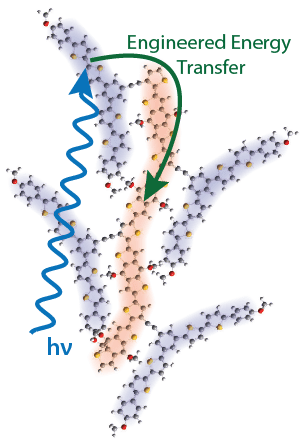Classes Taught
- General Chemistry
- Analytical Chemistry
- Experimental Physical Chemistry
- Masters-level Quantum Mechanics
- Masters-level Statistical Mechanics in Molecular Dynamics
Research Interests
The Griffin group applies spectroscopic and computational methods to characterize electronic dynamics. Our current area of focus is charge and energy transport in conjugated organic materials. By electronic behavior at the molecular level, we aim to improve performance in organic photovoltaic materials and create new organic electronic device architectures based on alternative molecular functionalities. Organic photovoltaics have tremendous potential to reduce the environmental impact of our energy generation infrastructure, if they can be made cost-competitive with conventional, consumable energy sources.
 Figure 1. The Griffin group investigates electronic behavior in many types of systems, including small conjugated organics (left), networks of such molecules (center), and polymers (right). Absorbing units of the molecules, called chromophores, are highlighted here with transparent colored shapes.
Figure 1. The Griffin group investigates electronic behavior in many types of systems, including small conjugated organics (left), networks of such molecules (center), and polymers (right). Absorbing units of the molecules, called chromophores, are highlighted here with transparent colored shapes.
One ongoing project aims to create materials that will support a new generation of solar cells with only one active component. Current organic photovoltaics use a blend of charge-donor and charge-acceptor molecules, and for optimal device performance the morphology of this blend must be controlled on nanometer length scales. We hope to remove this constraint by creating polymers that contain both donor and acceptor moieties, facilitating easier and more reliable device processing.
 Figure 2. A decorated polymer with engineered energy flow between donor and acceptor moieties.
Figure 2. A decorated polymer with engineered energy flow between donor and acceptor moieties.
We also investigate the molecular characteristics that affect electronic dynamics in small molecules. These studies combine spectroscopy and computation to identify the chemical properties that control electronic relaxation dynamics. By working with small molecules, we are able to clearly demonstrate the microscopic mechanisms that control electronic processes. Results from these studies can then inform our work on polymeric systems and bulk materials.
Another project applies computational tools to investigate the role of quantum mechanics in energy transport in organic photovoltaics. Recent experimental results demonstrate that excitations in polymer-based solar cells travel more quickly through the materials than purely classical mechanisms predict. We will apply quantum mechanical models to investigate whether quantum mechanisms can explain these results.
Selected Publications
- Fligelman, A., Johns, G., Guyn, A., Petrauskas, A., Vadola, P. A., Griffin, G.B. Electronic Relaxation Dynamics in 2-Quinolinones with Extended Conjugation. Journal of Physical Chemistry A, 125, 9757–9769.
- Grice, K. A., Griffin, G. B., Sun Cao, P., Saucedo, C., Niyazi, A. H., Alkadheel, F., LeSuer, R. J. (2018). Elucidating the solution-phase structure and behavior of 8- hydroxyquinoline zinc in DMSO.
Journal of Physical Chemistry A, 122, 2906–2914.
- Bednarz, M., Lapin, J. L., McGillicuddy, R., Pelzer, K., Engel, G. S., Griffin, G. B. (2017). Modeling Ultrafast Exciton Migration Within the Electron Donor Domains of Bulk Heterojunction Organic Photovoltaics.
The Journal of Physical Chemistry C, 121, 5467.
- Decker, K., Gould, A., Labedz, P., Rederer, J., Griffin, G. B., Kewalramani, S., Rubert Perez, C. M. Self-Assembly of Histidine Containing Metal-Binding Amphiphilic Small Molecules. Materials Chemistry Today, 33, 101736.
Service and Professional Activities
- Director of Communications for The Department of Chemistry & Biochemistry
- Chair of InCoRe, Assessment Committee
- Member of University Student Access Committee (USAC), CSH Research Committee, and CSH Showcase Committee
Professional Society Memberships
- American Chemical Society (ACS)
- National Organization for the Professional Advancement of Black Chemists and Chemical Engineers (NOBCChE)